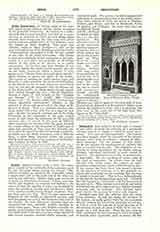

Sedia Gestatoria, the Italian name of the portable papal throne used on certain solemn occasions in the pontifical ceremonies. It consists of a richly-adorned, silk-covered armchair, fastened on a suppedaneum, on each side of which are two gilded rings; through these rings pass the long rods with which twelve footmen (palafrenieri), in red uniforms, carry the throne on their shoulders. Two large fans (flabella) made of white feathers—a relic of the ancient liturgical use of the flabellum, mentioned in the “Constitutiones Apostolic”, VIII, 12-are carried at the sides of the Sedia Gestatoria. This throne is used more especially in the ceremonies at the coronation of a new pope, and generally at all solemn entries of the pope to St. Peter’s or to public consistories. In the first case three bundles of tow are burnt before the newly-elected pontiff, who sits on the Sedia Gestatoria, whilst a master of ceremonies says: “Sancte Pater sic transit gloria mundi,” (Holy Father, so passes the glory of the world). The custom of carrying the newly-elected pope, and formerly in some countries the newly-elected bishop, to his church can be, in some instances, traced back very far and may be compared with the Roman use of the Sedis curulis, on which newly-elected consuls were carried through the city. Already Ennodius, Bishop of Pavia (d. 521) records in his “Apologia pro Synodo” (“P.L.”, LXIII, 206; “Corpus Script. eccl.”, VI, Vienna, 1882, 328) “Gestatoriam sellam apostolicae confessionis” alluding to the cathedra S. Petri, still preserved in the choir of St. Peter’s at Rome. This is a portable wooden armchair, inlaid with ivory, with two iron rings on each side. Besides the present constant use of the Sedia Gestatoria at the coronation of the pope (which seems to date from the beginning of the sixteenth century), etc., it served in the past on different other occasions, for instance when the pope received the yearly tribute of the Kingdom of Naples and of other fiefs, and also, at least since the fifteenth century, when he carried the Blessed Sacrament publicly, in which case the Sedia Gestatoria took a different form, a table being adjusted before the throne. Pius X made use of this on the occasion of the Eucharistic Congress at Rome in 1905.
LIVARIUS OLIGER

